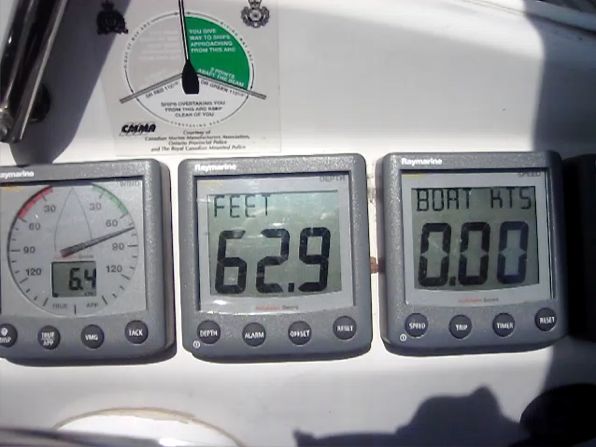Hove to
One of the important seamanship skills on our practice agenda was (is) “heaving to.” With plenty of time on our hands and some pleasant sailing weather last week, we decided to give it a go. Did it work? Textbook!

Now, given that we had our entire Genny out at the time, we really wouldn’t want to keep the sails in that same configuration for too long as I’m sure we would end up with a lot of chafe over time. We’ll have to experiment some more to see how the boat balances with the sails reefed.
For those not familiar with heaving to, this link explains it pretty well. And if you want some more good boat-related reading, check out the blog Hove to off Swan Point. It is written by Russ Manheimer, the father of our first sailing instructor, Captain Dave. It is father’s day after all!


I am soooo embarrassed……I always thought Heave Ho was when someone had too much to drink…Stupid John
Actually, not textbook, not for a cat.
Look at the apparent wind angle – almost beam-on. That is the one place you don’t want to be in a cat when the wind and waves get up. That said, I think you did everything correctly – I get the same result with full sail.
We both need to play with it in higher winds. I suspect the small rudders are a problem. I suspect that rolling up most of the jib would help.
However, for MOB recovery with 2 for crew, I think it would work great. Most of the time, if under sail, I think the best thing to do is quickly stop the boat and get something floatable in the water. Then, not moving, slowly figure it out. While all of those “under sail” recoveries are cute and seaman-like with a full crew, I suspect I would drop sail and turn on the engines, if it was too far for them to swim. Less to go wrong.
For MOB I agree. Tack quick to stop the boat and then deal with it. One more thing that we need to practice! Or at least, Rebecca needs to practice. 🙂
The “Quickstop” maneuver is now the recommended on for COB rescues. You are right on about all the moving around. I’d rather stop ASAP and keep my eye on whoever is on the water. Of course, since I singlehand, my version of the Quickstop is a bit different! 🙂
Just curious, other than not falling overboard, or trailing a long line behind the boat, do you have some method Helen? I think there is some device which, if the solo Capt. falls overboard, it will put the boat into irons? I might just be imagining this though.
Helen, I’d be curious to hear what you use.
Last month’s TCP #42 page 10 (a yachting rag out of Australia, see http://www.thecoastalpassage.com ) described a pretty interesting setup for solo sailors with tiller steering. It was basically a long trailing line (could also be hooked to a tether) and a bit of shock cord, connected to the self-steering arm with a light cord through a couple of blocks. If you fall overboard, you grab the line (it trails ~ 40 m astern) and the added drag from your body stretches the shock cord, causing the light cord to pull the self-steering arm and pull the boat into irons.
Not sure how you’d make it work on a faster boat like your cat, or with wheel steering… but interesting nonetheless.